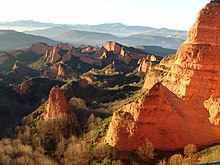El Bierzo
The Bierzo is a landscape in the autonomous community of Castile and León in northwestern Spain. The comarca of the same name covers the extreme western part of the province of León, borders the Asturias region in the north and the Galicia region in the west . The area covers an area of 2,828 km², in which 134,738 people live (as of 2007), about half of them in the capital Ponferrada . The Bierzo is also known as a wine-growing area .
Geographical location
The Bierzo is a tectonic basin that is around 500 m above sea level and is surrounded by mountain ranges around 2000 m high. This separates it in the northwest with the Sierra de Caurel and the Sierra de los Ancares of Galicia, in the north with the Cantabrian mountain range and the Sierra de Gistredo of Asturias, in the northeast with the Montes des León from the rest of the province and in the south and southeast with the Montes Aquilanos and the Sierra de Pobladura from the province of Zamora and the Leonese region of La Cabrera . The main river of the Bierzo is the Sil , which flows into Galicia .
There are three regions to be distinguished:
- Bierzo del Este: Region east of Ponferrada on the Río Boeza around Bembibre
- Bierzo Alto: Region north of Ponferrada
- Bierzo Bajo: Region around Ponferrada and Carracedelo
population
Because of the geographical isolation up to the end of the 1960s, the “Bercianos” did not lose their own dialects, their culture, eating habits and political attitudes. They don't feel like Galicians, Asturians or citizens of the Leonese North Meseta .
The traditional dialectal ways of speaking of Bierzo are counted as Galician in the west (around Villafranca) and Leonese in the east . The young population, however, mainly speaks Castilian , the Spanish national language.
Cities and municipalities in El Bierzo
Climate and vegetation
The Bierzo has its own microclimate. Here the north-western maritime climate of Galicia and Asturias mixes with the continental climate of the northern Meseta , the surrounding mountain ranges keep cold winds off. The result is excellent fruit, vegetable and wine growth .
irrigation
The entire basin is fed by the Rio Sil , which later flows into the Rio Miño and drains into the Atlantic Ocean. Its main tributaries are:
- Rio Burbia (Sierra de los Ancares)
- Rio Cúa (Valle de Fornela, El Cuadro)
- Rio Boeza (Sierra de Gistredo)
The Barcena reservoir above Ponferrada feeds an extensive and effective irrigation system that specifically guarantees the important harvests of the lower Bierzo.
economy
Until a few years ago, the mining of high-quality anthracite coal with the centers of Fabero, Toreno, Bembibre and Brañuelas shaped the economy. This was associated with metal smelting and the electricity industry with the Compostilla coal-fired power station, which was founded in 1944, northeast of Ponferrada. As everywhere in Europe, this sector declined steadily. Many small mines had to close and give way to a large opencast mine north of Fabero. Of further importance is the slate quarrying near Puente de Domingo Florez and the cement industry in Toral de los Vados and the glassmaking in Camponaraya.
In addition, there is a wide network of small and medium-sized industrial companies. Like everywhere else in the country, the service sector is also growing, with Ponferrada at the center.
The agriculture is characterized by the cultivation of wine, fruit, peppers and tomatoes, and meat production (chorizo, salami and ham).
The centers of cultivation and marketing of red wine from the Bierzo appellation are Cacabelos , Villafranca del Bierzo , Camponaraya and Cabañas Raras. The most important grape variety is the Mencía grape.
Cities and sights
The main attraction is the Roman gold mine Las Médulas near Carucedo, southwest of Ponferrada . It has been declared a World Heritage Site. In addition, the Mozarabic churches of Santiago de Peñalba and Santo Tomás de las Ollas from the 8th century, the old forge in Compludo and the huge Templar ruins in Ponferrada should be mentioned.
Villafranca del Bierzo , an important pilgrimage town in the past, offers many art treasures such as B. the mercy gate Puerta de Perdon, the collegiate church La Colegiata etc.
tourism
The Bierzo was mostly a stopover on the way to Galicia. The Way of St. James crosses the region from northeast to southwest. Stops are the Rabanal Pass , El Acebo , Molinaseca , Ponferrada, Camponaraya, Cacabelos and finally Villafranca del Bierzo with the Valcarce .
swell
- El Bierzo by JM Voces Jolias and José Antonio Iglesias / Ediciones Lancia SA León



